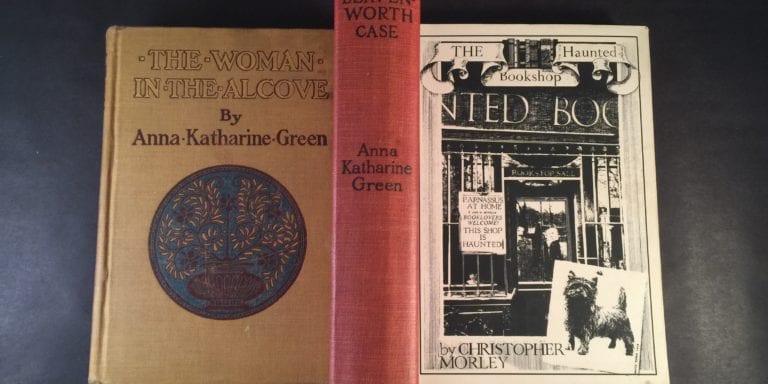
This story was written about 15 years ago and updated for this blog.
A Mrs. Minnich called me for an appointment about a year after I opened in 1980. She told me she had some collectible mysteries she wanted to sell.
Why me?
At that point, my stock was mostly junk. I specialized in whatever I could get my hands on to fill the shelves. So when the sweet matronly middle-aged lady arrived with a small burlap embroidered canvas bag containing eight books, I was prepared to be disappointed. I knew that with so few books either the quality would be too high and I could not afford them or that the titles would be marginal and the minuscule offer I’d make would look bad.
Sure enough, she pulled six Anna Katharine Green and two Christopher Morley firsts from her tote.
Anna Katharine Green was sort of the “mother” of the mystery story. In 1878 she published her first and best-known novel, The Leavenworth Case. This may be the first Detective Mystery written by a woman. It was a bestseller, and she went on to write several dozen books—many of them detective mysteries and whodunits. She wrote 3 mysteries featuring Amelia Butterworth—foreshadowing Miss Marple and the female spinster amateur detective series to come.
Wikipedia also credits her with writing the first “girl detective” novel. It features debutante Violet Strange and foreshadows Nancy Drew and her ilk.
Here’s a bit more From Wikipedia:
In a discussion of women writers of detective fiction, scholar Ellen Higgins in 1994 chronicled the work of Green as popularizing the genre a decade before Arthur Conan Doyle brought out his first Sherlock Holmes story. “I only found out afterward that some people were a little upset with it because they don’t want to hear about women competing with the master,” Higgins said.
I’ll let you read the rest about her groundbreaking yourself. Just Google this mostly forgotten, Buffalo, NY writer.
She was a tough sell then (and now.) Only specialist academics, collectors, and dealers have ever heard of her. Specialists who are willing to pay retail seldom visited provincial general used bookshops with no reputation or advertising budget. Should one ever visit, dealers in arcane mysteries would not have been able to make any money purchasing my copies since I paid Mrs. Minnich a high wholesale price in order to acquire them.
Christopher Morley is one of those authors who fall under the category:
“Used to be collected.”
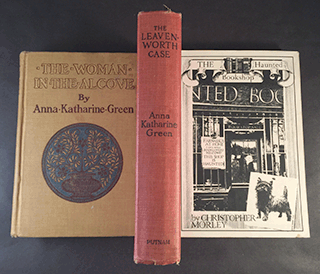
He was a fascinating literary character in the early and mid 20th century. He was very important in American book society as well. He eschewed that nest of vipers in The Algonquin Round Table but had his own literary circles. One of which he named the Three Hours for Lunch Club. According to the site Restaurant-ing Through History: Three Hours for Lunch was succeeded by another club, the Baker Street Irregulars, which Morley—a Sherlock Holmes fan—formed at Prohibition’s end. (link to article)
After his death, two New York newspapers published his last message to his friends:
Read, every day, something no one else is reading. Think, every day, something no one else is thinking. Do, every day, something no one else would be silly enough to do. It is bad for the mind to continually be part of unanimity.
(Wikipedia)
Christopher Morley wrote over 100 books including a million-copy bestseller Kitty Foyle. This book is notable in that it was an early story to deal with the subject of abortion. A popular movie was made of it, and Ginger Rogers won the Academy Award for Best Actress in 1940. By the early 1980s his fans were mostly aged or dead. The aged ones had all the Morley books they wanted and the dead ones were selling theirs.
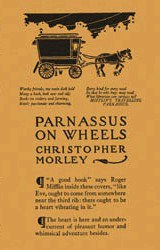
BUT if you are a book lover his Parnassus on Wheels and The Haunted Bookshop are still really good reads. REALLY good! A hint: they are both about bookselling—from a woman’s perspective. The Haunted Bookshop adds some mystery to its plot as well. Most everything else he wrote is forgotten.
Still, I had to go through the motions. At that time there were two good price guides available. One was Van Allen Bradley’s 1972 Book Collector’s Guide to Values. His earlier book Gold in Your Attic had done a lot to encourage novices to bring in their “gold” to book dealers to exchange for cash. Almost invariably the collectible first editions brought in by those who referenced him would be lacking something crucial like a bibliographical point.
Or a dust jacket.
Or a title page.
When you gave the customer (who had walked in with visions of exchanging the two boxes of Uncle Arthur’s “rare” books for four days in the Bahamas) the disappointing news, they in turn would often become suspicious or angry at my incompetence or deceitfulness. The other price guide was a much more comprehensive and much less romantic piece, titled simply Guide to Used Book Prices. We, in the trade, called it Mandeville after its compilers. This was a big heavy tome bound in plain reddish brown buckram. Each page was double-columned with dozens of sterile small print listings of books by author. Brief condition and edition descriptions were followed by a “retail” value for each book. It was designed for trade use and for all its faults was often the only life raft in the sea of books of all genres the general novice book dealer would be asked to look at. Several more Mandeville volumes were produced subsequently.
That is how primitive things were before this World Wide Web thing got invented. Much of what was to be learned about book valuations was via visits to other book shops, collectible book shows, expert dealer catalogs and the “School of Hard Knocks” (i.e. finding out something you sold for a few dollars was worth hundreds.)
Damned if Mrs. Minnich’s books weren’t listed in Mandeville and with relatively high prices too. But I knew I could easily sell three hundred $3.00 books before I could turn over one of her $100.00 firsts. But then, a few $100.00 books would have some marquee value for the shop despite their relative obscurity. What to offer her? I had nothing to trade. So I stammered my deal to her. This was a new exercise for me—buying books one at a time. I told her (and she knew) what her books were worth at retail. I then tried to explain why I could only offer a fraction of that to her. In actuality, I over paid for those few books for I don’t believe I ever sold them—even after marking them down time after time every few years. (In fact I’m pretty sure I still have those two Morleys around the old house somewhere.) But she was way ahead of me. She smiled the warm smile I was to see for many years to come. She explained how she collected books. It was unique to me then. She was a micro collector. I doubt she ever kept more than a hundred books on hand. When she wanted some new collectible mystery, she would first sell off a few she’d tired of. She became the first “One book in, one book out” collector I knew. There were subsequent ones—of both genders—and there was usually a spousal vector involved in the equation.
Thus began a fun multi decade bookseller/book collector relationship.
Over the years she would call ahead and bring five or ten or twenty mysteries into me. Almost always a collection of one or two authors she was done with. Always in fine condition. She would bring in a run of Elizabeth Daly, and six months later some Barbara Michaels and Elizabeth Peters, then some Tony Hillerman.
Most of the books she brought in were far better and much easier to market authors and titles than Anna Katharine Green and Morley. She would open up to me personally sometimes and a picture emerged of a small home. She worked as a nurse and made good money but she worried her husband would not be happy if he knew what she spent on her books. Furthermore, her book space was very circumscribed—whether the space was self controlled or her husband dictated “this many shelves and no more” I never ascertained. But for many years she brought me great books, a few at a time and I imagined her buying eight or ten new books (from likely mystery specialists’ lists) for every eight or ten she sold me.
Why me?
Maybe I was her secret out-of-town outlet. Apparently, she did not want to sell the books back to the dealers she had bought from.
One book in. One book out.
And for all those years she used the same burlap shopping bag.
I got to really like seeing her lift that bag up onto the sales counter. I knew something really cool would be coming out of it.
The last time she came in her face was very puffy, her legs were swollen and I could tell she was quite ill. She held her hand in front of her mouth as she spoke. She was hiding a tired resigned smile. She said had been in the hospital and her teeth no longer fit. She didn’t want me to see her this way, but she wanted to see me and sell me some books. In the bag were a handful of recently published mysteries and a few Marcia Muller and Charlotte MacLeod. But she also had Sue Grafton’s B, C, D, and E autographed. I always thought the Grafton books were vastly overpriced for the quality of the writing. I suspected their value would plummet when the collecting frenzy wore off and collectors actually considered the work rather than the alphabet.
Still, I asked, “What, no A is for Alibi?”
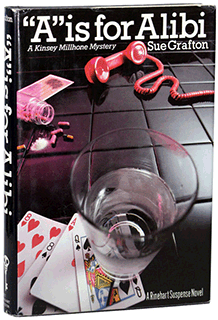
“Oh, my!” she chuckled. “I have to keep something, and I had so much trouble getting that book.”
Somehow I knew I’d never see her again. I wonder what happened to that last collection she held onto. Did her husband dump her shelf of books? She had always meticulously eliminated any indication of any penciled price above the original retail. But maybe he knew her “game” and pretended he knew nothing of her “Gentle Madness.” Her bibliomania manifested itself not in hoarding or building a library, but in plucking a few gems and when the time came, replacing those gems with a few more.
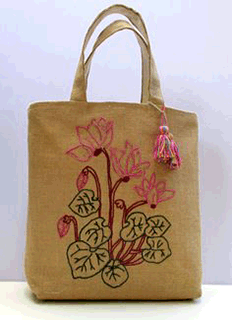

There are no comments to display.